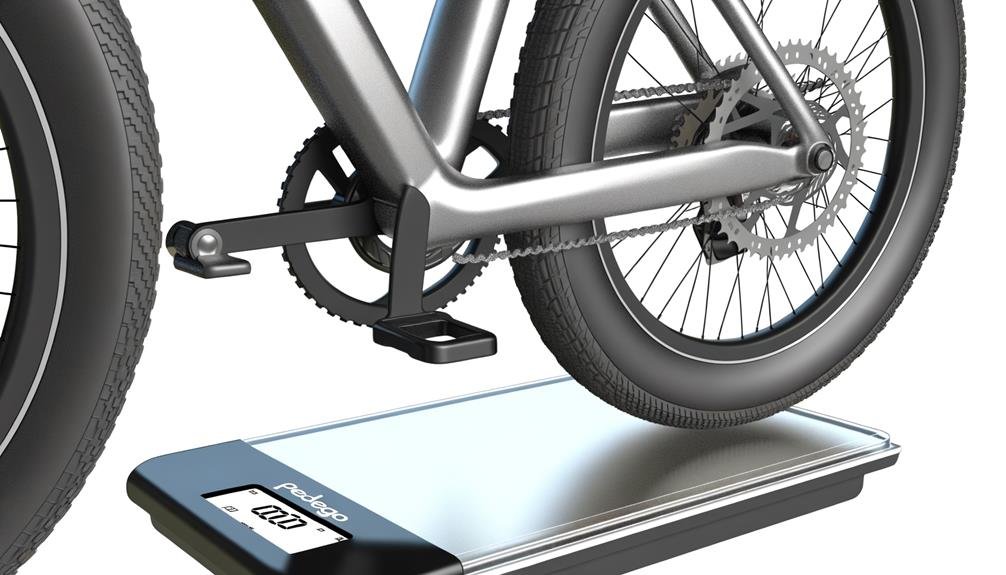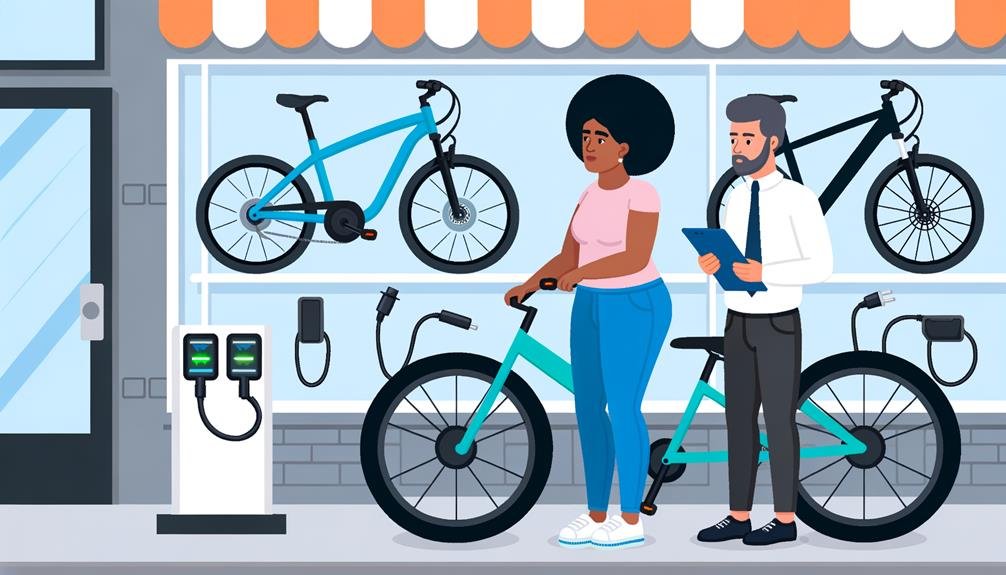Charles Miller is a veteran bike enthusiast with over 12 years of experience dealing with bikes as a mechanic. Despite immense love and expertise for...
Even though all electric bikes may seem similar at first glance, it's not just about the battery power and the distance they can cover.
Electric bikes are classified into specific categories, known as classes, which define their capabilities and how they're used. We've got Class 1, 2, and 3 e-bikes, each offering unique features and advantages.
It's these classes that determine where you can ride your bike and how fast you can go on it. As we discuss these classes, you'll find out how they impact not only the performance of electric bikes but also their legality and use in different scenarios.
So, why does this classification matter? Stick with us, and you'll discover just how crucial these classes can be in helping you choose the right e-bike for your needs.
- Key Takeaways
- Defining Electric Bike Classes
- Importance of E-Bike Classes
- In-depth: Class 1 E-Bikes
- Understanding Class 2 E-Bikes
- The Power of Class 3 E-Bikes
- E-Bike Classes and Legislation
- Choosing the Right E-Bike Class
- Class-Specific E-Bike Features
- E-Bike Classes and Performance
- E-Bike Classes and User Experience
- Frequently Asked Questions
- Conclusion
Key Takeaways
- Electric bike classes (Class 1, Class 2, and Class 3) define speed limits and motor activation methods.
- Class 1 e-bikes have a top speed of 20 mph and the motor is activated only when the rider is pedaling.
- Class 1 e-bikes can be ridden on bike paths and shared lanes without a license.
- Class 2 e-bikes have a top speed of 20 mph and can be operated with a throttle, while Class 3 e-bikes can reach speeds up to 28 mph and may or may not have a throttle depending on state regulations.
Defining Electric Bike Classes
What exactly are these electric bike classes, you may ask? They're essentially categories, namely Class 1, Class 2, and Class 3, that differentiate ebikes based on their speed limits and motor activation methods. When we talk about defining electric bike classes, we're delving into the classification system that segregates these ebikes into their respective categories.
Class 1 ebikes, as part of the three classes, are limited to a top speed of 20 mph, with the electric motor kicking in only when we're pedaling. Class 2 ebikes also have a top speed of 20 mph, but what sets them apart is their ability to be activated with a throttle, even when we're not pedaling. Lastly, Class 3 ebikes push the limits, reaching up to an impressive 28 mph. However, their motor activation methods may vary, as they're subject to state regulations.
Why does this matter, you might wonder? Well, electric bike classes are essential for guiding usage. They help us understand where and how we can ride our ebikes, making sure we're always in line with state and local laws. Not only does this classification system ensure our safety, but it also promotes responsible ebike usage.
Importance of E-Bike Classes
Unraveling the significance of e-bike classes, it's crucial to understand that these classifications not only differentiate between Class 1, 2, and 3 eBikes and their respective speed limits, but they also provide a framework for legal implications and usage restrictions.
Understanding what're electric bike classes and their importance can be outlined as follows:
- Legal Compliance: Each class has specific laws and regulations. Being aware of the types of electric bikes ensures you're abiding by the law.
- Usage Restrictions: Some paths may restrict certain e-bike classes. By knowing your eBike class, you can avoid penalties or fines.
- Speed Limits: Each class has a different speed limit which affects where and how you can use your eBike.
- Consistency: These classes provide a standard across the industry, making it easier for riders to understand their bike's capabilities and restrictions.
In-depth: Class 1 E-Bikes
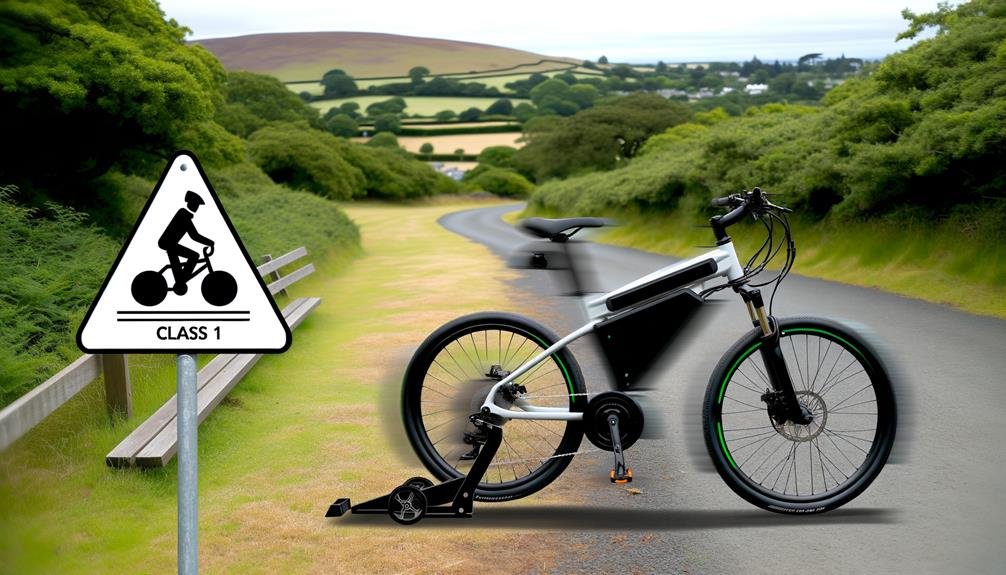
Now we're moving onto our in-depth look at Class 1 E-Bikes. We'll explore their specific features, including the necessary pedaling and speed limitations.
Additionally, we're going to unpack the legalities surrounding this class of e-bikes, like where you can ride them and any restrictions you might face.
Class 1 E-Bike Features
Delving into the nuances of Class 1 e-bikes, it's key to note that these models, including the popular Propella 7S, Trek FX+ 2, and Tern GSD S00, are limited to a top speed of 20 miles per hour and only engage the electric motor when the rider is actively pedaling.
When it comes to ebike features that set Class 1 ebikes apart, we can highlight:
- The pedal assist system: It requires active pedaling to engage the motor power.
- Speed limit: Capped at 20 mph, providing a controlled and safe riding experience.
- Legal status: These ebikes can be ridden on bike paths and shared lanes without a license.
- Throttle: Absent in Class 1, emphasizing the bike's traditional cycling feel.
Understanding these electric bike classes helps us appreciate the diversity in ebike design.
Legalities for Class 1
Building on our understanding of Class 1 e-bike features, let's explore the legalities that govern their use, offering riders not only a unique cycling experience but also a clear understanding of their rights and responsibilities on the road.
As part of electric bike classes, Class 1 ebikes are generally treated like conventional bicycles under local laws. They can be ridden on bike paths and lanes shared with regular bikes, extending their usability. They don't require a driver's license, making them accessible to a wider audience.
However, it's important to remember that regulations may vary slightly from place to place, so it's wise to keep abreast of the specific laws in your area. Understanding these legalities helps maintain harmony among all road users.
Understanding Class 2 E-Bikes
Diving into the specifics of Class 2 E-bikes, it's important to note that these bikes, including models like the Lectric XP 3.0, Wing Freedom 2.2, and Aventon Soltera, can reach top speeds of 20 miles per hour and their throttles function even when not pedaling. This motor assist feature sets them apart from other electric bike classes.
To understand more about Class 2 ebikes, consider these four key factors:
- Speed and Control: With a top speed of 20 mph, they offer a balance of speed and control.
- Motor Assist: Even without pedaling, the throttle function provides a continuous motor assist, making for effortless rides.
- Versatility: They can be ridden on streets, bike lanes, and multi-use bike paths, just like traditional bikes.
- Variety: Numerous ebike manufacturers produce different types of Class 2 E-bikes to suit varied needs and preferences.
Belonging to the Class 2 E-bike community means experiencing the joy and convenience of cycling, while also enjoying the perks of technology. It presents a unique combination of tradition and innovation, making every ride worthwhile.
The Power of Class 3 E-Bikes
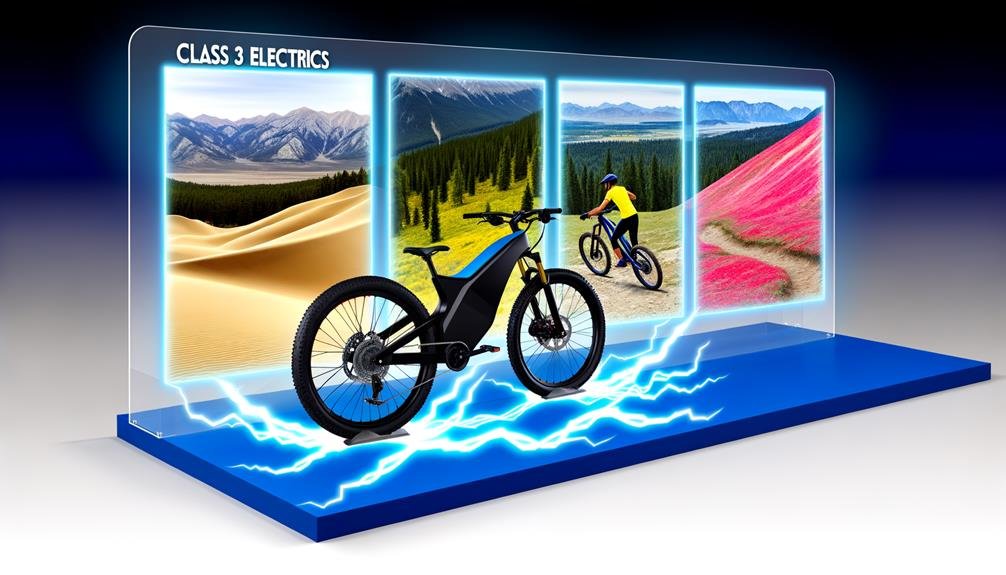
Stepping up the pace, Class 3 e-bikes pack a powerful punch, capable of reaching speeds up to 28 miles per hour and surpassing their Class 1 and 2 counterparts. This maximum speed, combined with the speed and power that Class 3 ebikes are capable of, make them the ideal choice for those seeking higher speeds and more robust performance.
It's important to note, however, that with greater power comes greater responsibility. Class 3 ebikes, given their higher speeds, are subject to more regulations and restrictions. Some states even require that these bikes feature additional safety components such as lights and turn signals.
While some manufacturers offer options to unlock even higher speeds, we must stress the importance of adhering to local laws and regulations. After all, we're not just riders, we're members of a broader community who share the road and trails with others.
E-Bike Classes and Legislation
When it comes to e-bike classes and legislation, it's crucial to understand that each class of e-bikes has specific regulations and restrictions tied to it, making it necessary to research local state and city laws before making a purchase. We're here to guide you through the essentials, offering clarity about these classes and the laws concerning them.
To begin with, let's outline the three main classes of electric bikes:
- Class 1: These e-bikes have a top speed of 20 mph and only provide assistance when you're pedaling.
- Class 2: Like Class 1, these also cap at 20 mph, but can be operated with a throttle, even without pedaling.
- Class 3: These are quicker, reaching up to 28 mph, but they may or may not feature a throttle, based on state regulations.
Some manufacturers offer the option to unlock higher speeds with switchable settings and rider cooperation. However, it's important to remember these modifications may not align with your local laws. We encourage belonging to the e-bike community, but advise doing so within the legal framework of your locale.
Be informed, be smart, and enjoy your ebike responsibly.
Choosing the Right E-Bike Class
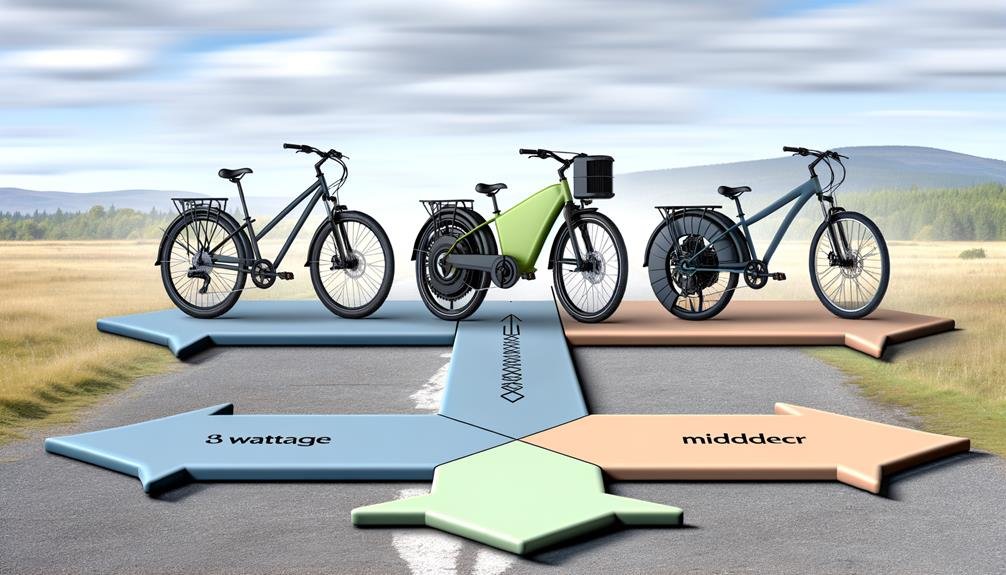
Having explored the nuances of e-bike classes and their associated legislation, let's now help you navigate the complex task of selecting the right class based on your specific needs and local laws. When choosing the right e-bike class, consider your biking habits, where you'll be riding, and your comfort with speed.
Here's a comparison table to help you visualize the differences among e-bike classes:
| E-Bike Class | Top Speed & Motor Activation |
|---|---|
| Class 1 | 20 mph, pedal-assist only |
| Class 2 | 20 mph, throttle-activated |
| Class 3 | 28 mph, may have a throttle |
If you regularly bike on bike paths or in city traffic, a Class 1 or 2 electric bike might suit your needs. However, if you're looking for more speed and can handle the increased responsibility, a Class 3 bike could be your choice. Also, remember that some manufacturers allow unlocking higher speeds.
In our quest to understand 'what are electric bike classes and why do they matter?', we must not forget that local state and city laws play a crucial role, so always check the regulations in your area.
Class-Specific E-Bike Features
Understanding the unique features of each e-bike class is critical to making an informed purchase.
We'll analyze the distinct elements such as top speeds and motor activation methods, and how these vary across the different classes.
We'll also discuss the importance of these features in relation to regulations and rider preferences.
Understanding E-Bike Categories
So, what sets apart Class 1, Class 2, and Class 3 ebikes, and how do they differ from scooters and electric motorcycles? Here's a quick breakdown to deepen your understanding of e-bike categories.
- Class 1 ebikes only provide electric assistance while you're pedaling, with a top speed of 20 mph.
- Class 2 ebikes can reach the same speed even without pedaling, thanks to their throttle.
- Class 3 ebikes crank up the speed to 28 mph, with or without a throttle.
- Electric motorcycles are a different breed altogether, more akin to traditional motorbikes but powered by electricity.
Importance of Class Features
After examining the differences between Class 1, Class 2, and Class 3 ebikes, it becomes clear why grasping the unique features of each class is vital for riders.
These electric bike classes serve as a compass, guiding us where and how we can ride, ensuring we're always in line with local laws.
The importance of class features goes beyond legal compliance. They directly impact our riding experiences, offering different speed limits and usage restrictions.
By understanding what're electric bike classes and why they matter, we're able to make informed decisions. This knowledge allows us to select a class that resonates with our riding preferences, safety concerns, and legal requirements.
In essence, these classes enable us to find our perfect ride.
E-Bike Classes and Performance

When it comes to the performance of electric bikes, the distinction between Class 1, 2, and 3 ebikes plays a pivotal role, dictating their top speeds, mode of operation, and where they can legally be ridden.
- Class 1 ebikes: These are all about pedal power. You'll need to keep pedaling for the electric motor to kick in, assisting you up to a top speed of 20 mph. Their use is generally accepted on any path where regular bikes are allowed.
- Class 2 ebikes: These offer the same top speed as Class 1, but with added flexibility. You can use the throttle to engage the electric motor without pedaling, making them perfect for those who prefer a more relaxed ride.
- Class 3 ebikes: These are the speed demons of the electric bike world. They offer a higher top speed of up to 28 mph, but their usage is more regulated. Some states require licensing and limit where they can be ridden.
- Unlocking higher speeds: Some manufacturers offer switchable settings that enable you to unlock higher speeds. However, this requires rider cooperation and knowledge of local regulations.
Understanding these e-bike classes and performance capabilities will help you find an ebike that suits you and is legal in your area.
E-Bike Classes and User Experience
As we turn our focus to the impact of e-bike classes on user experience, it's evident that understanding these categories is crucial.
The class of an e-bike can significantly determine the riding experience, with factors like top speed and pedaling requirements playing key roles.
We'll also consider how switchable settings and local regulations might affect a rider's interaction with their e-bike.
Understanding E-Bike Classes
To fully appreciate the impact of e-bike classes on user experience, we need to delve into the specifics of how these classes differ in terms of speed, motor assistance levels, and legal requirements.
Understanding e-bike classes is key to enjoying the benefits of these bikes while abiding by your local regulations. Here's a brief rundown:
- Class 1 e-bikes are pedal-assist, topping at 20mph.
- Class 2 e-bikes, while maintaining the same speed limit, also offer a throttle-powered mode.
- Class 3 e-bikes reach up to 28mph, exclusively pedal-assist, and might necessitate special licensing in certain areas.
- Each class caters to diverse preferences, thus affecting your overall riding experience.
Understanding these classes provides belonging, empowering you to make informed decisions about which e-bike suits your needs and lifestyle best.
Impact on Riding Experience
Having explored the specifics of e-bike classes, let's now scrutinize how these classifications impact your actual riding experience.
Class 1 e-bikes, with motor activation upon pedaling, offer an experience reminiscent of traditional cycling, but with added support.
The throttle-based Class 2 e-bikes offer easy acceleration, which, although thrilling, can drain the battery quicker and limit where you can ride.
The Class 3 e-bikes, on the other hand, provide a faster, more powerful ride, perfect for road commuting.
The impact on riding experience thus varies greatly between electric bike classes. Understanding these distinctions is key to picking the right class for your specific needs, and to truly feel a sense of belonging within the e-bike community.
Frequently Asked Questions
What Is a Class 4 Electric Bike?
We're talking about Class 4 electric bikes here. They're like motorcycles, requiring licenses and registrations. With speeds above 28 mph, they offer thrilling rides but follow strict safety regulations. Maintenance and battery life are also significant considerations.
Are Class 3 E-Bikes Legal in California?
Yes, Class 3 e-bikes are legal in California. But, we must follow California regulations such as speed limitations, helmet requirements, and specific riding locations. It's also crucial we adhere to all traffic laws.
Are Class 3 E-Bikes Legal in Pa?
We've researched PA legislation and found Class 3 e-bike usage is legal. However, there're restrictions and safety measures to follow. Failure to comply can lead to legal consequences. Always stay informed and ride safely.
What Is the Difference Between an E-Bike and an Electric Bike?
We've noticed no difference between an e-bike and an electric bike. They both offer benefits like improved fitness, but drawbacks include battery longevity and maintenance costs, which can affect the riding experience.
Conclusion
So, understanding electric bike classes is like navigating a roadmap for your e-bike journey. It helps us choose the right path, ensuring safety and enjoyment. These classes aren't mere labels, they're keys to unlocking the full potential of our e-bike experience.
They guide us in performance, features, and usage, making our e-bike journey not just a ride, but an adventure well-equipped and well-informed.

Charles Miller is a veteran bike enthusiast with over 12 years of experience dealing with bikes as a mechanic. Despite immense love and expertise for his Tacoma, he rides his Trek Ebike more. Anytime you meet him, you’ll either hear him talking about Bikes, or writing about all things bikes and cars on this blog.
More Posts
